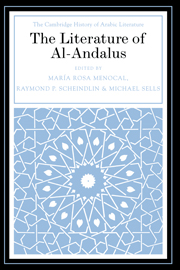Book contents
- Frontmatter
- 1 Visions of al-Andalus
- PART I THE SHAPES OF CULTURE
- PART II THE SHAPES OF LITERATURE
- PART III ANDALUSIANS
- 10 Ibn Ḥazm
- 11 Moses Ibn Ezra
- 12 Judah Halevi
- 13 Petrus Alfonsi
- 14 Ibn Quzmān
- 15 Ibn Zaydūn
- 16 Ibn Ṭufayl
- 17 Ibn ʿArabī
- 18 Ramon Llull
- 19 Ibn al-Khaṭīb
- PART IV TO SICILY
- PART V MARRIAGES AND EXILES
- PART VI TO AL-ANDALUS, WOULD SHE RETURN THE GREETING
- Index
- References
11 - Moses Ibn Ezra
from PART III - ANDALUSIANS
Published online by Cambridge University Press: 28 May 2012
- Frontmatter
- 1 Visions of al-Andalus
- PART I THE SHAPES OF CULTURE
- PART II THE SHAPES OF LITERATURE
- PART III ANDALUSIANS
- 10 Ibn Ḥazm
- 11 Moses Ibn Ezra
- 12 Judah Halevi
- 13 Petrus Alfonsi
- 14 Ibn Quzmān
- 15 Ibn Zaydūn
- 16 Ibn Ṭufayl
- 17 Ibn ʿArabī
- 18 Ramon Llull
- 19 Ibn al-Khaṭīb
- PART IV TO SICILY
- PART V MARRIAGES AND EXILES
- PART VI TO AL-ANDALUS, WOULD SHE RETURN THE GREETING
- Index
- References
Summary
Of all the Arabized poets of the Hebrew Golden Age in al-Andalus, Moses (Abū Hārān) Ibn Ezra is the one whose poetry most resembles that of an Arabic poet. Yet his literary career was more varied than that of most Arabic poets, reflecting the interests of the Jewish aristocrats of his age. The interplay of Arabo-Islamic and Jewish elements, a fascinating feature of the lives and careers of all the leading Hebrew poets of al-Andalus, is so fully developed in him as to render him a model case of an Andalusian Jewish intellectual.
Ibn Ezra’s life is known only in outline (Ibn Ezra, Selected Poems xxiii–xxxix; Schirmann 380–420). He was born in Granada, around 1055, to a distinguished family, several of whose members were, like Samuel and Joseph Ibn Nagrila in the preceding generation, in the service of Ḥabbūs and Bādīs of Granada. Moses’ elder brother Isaac (Abū Ibrāhīm) seems to have been married to one of the Nagid’s daughters. As a young man, Moses studied at the academy of Lucena, training ground for many of al-Andalus’s courtierrabbis. The academy was headed at the time by Rabbi Isaac Ibn Ghiyāth, the premier rabbinic authority of al-Andalus and the premier liturgical poet of his generation.
- Type
- Chapter
- Information
- The Literature of Al-Andalus , pp. 252 - 264Publisher: Cambridge University PressPrint publication year: 2000
References
- 3
- Cited by



